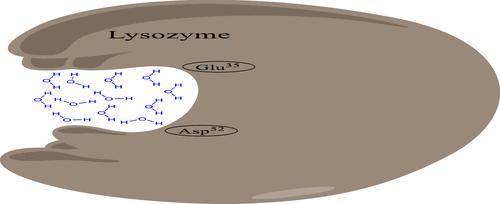当前位置:
X-MOL 学术
›
J. Chem. Eng. Data
›
论文详情
Our official English website, www.x-mol.net, welcomes your
feedback! (Note: you will need to create a separate account there.)
Thermodynamic Studies of Aqueous Binary and Ternary Solutions Involving Lysozyme and Urea at 298.15 K
Journal of Chemical & Engineering Data ( IF 2.0 ) Pub Date : 2022-08-18 , DOI: 10.1021/acs.jced.2c00367 Deepti N. Kurhe 1 , Dilip H. Dagade 2 , Jyoti P. Jadhav 1 , Vasim R. Shaikh 3 , Kesharsingh J. Patil 4
Journal of Chemical & Engineering Data ( IF 2.0 ) Pub Date : 2022-08-18 , DOI: 10.1021/acs.jced.2c00367 Deepti N. Kurhe 1 , Dilip H. Dagade 2 , Jyoti P. Jadhav 1 , Vasim R. Shaikh 3 , Kesharsingh J. Patil 4
Affiliation

|
Measurements for osmotic pressure and densities for lysozyme in aqueous and aqueous solutions containing urea have been reported at 298.15 K using a vapor pressure osmometer and vibrating tube digital density meter, respectively. The partial molar volumes and activity coefficients of both the components and the osmotic pressure of the solutions have been calculated. The molar mass and second virial coefficient of lysozyme have been obtained using the McMillan–Mayer theory of solutions and are compared with the values obtained in aqueous salt solutions. The Guggenheim–Stokes equation for osmotic coefficient has been used to obtain the protein molecular diameter in an aqueous medium. The estimated diameter of lysozyme is similar in magnitude to that in the pure state, confirming the retaining of the native state of the protein in aqueous solutions over the studied concentration region. These studies have been extended to aqueous–urea (∼2.0 mol·kg–1) solutions at 298.15 K. Data of water activity and activity coefficient of all the three components in ternary solutions as a function of lysozyme concentration have been determined by the methodology developed by us earlier. The data have been further analyzed to obtain Gibbs free energy changes of transfer of lysozyme as well as that urea from corresponding aqueous binary to aqueous ternary solutions through which information about the binding of denaturant to protein can be derived. The analysis further reveals that the binding of urea to the protein molecules occurs through the breakdown of protein–water H–bonds leading to the opening of a coiled structure of lysozyme. All these results are discussed in terms of protein hydration, protein–protein hydrophobic interactions, and protein denaturant binding equilibria for the solutions of lysozyme.
中文翻译:

在 298.15 K 时涉及溶菌酶和尿素的二元和三元水溶液的热力学研究
分别使用蒸气压渗透压计和振动管数字密度计在 298.15 K 时测量了水和含有尿素的水溶液中溶菌酶的渗透压和密度。计算了两种组分的偏摩尔体积和活度系数以及溶液的渗透压。溶菌酶的摩尔质量和第二维里系数已使用 McMillan-Mayer 溶液理论获得,并与盐水溶液中获得的值进行比较。渗透系数的古根海姆-斯托克斯方程已被用于获得水介质中的蛋白质分子直径。溶菌酶的估计直径在大小上与纯态相似,确认在研究的浓度区域内保留了水溶液中蛋白质的天然状态。这些研究已扩展到尿素水溶液(~2.0 mol·kg–1) 溶液在 298.15 K。作为溶菌酶浓度函数的三元溶液中所有三种成分的水分活度和活度系数的数据已通过我们之前开发的方法确定。进一步分析数据以获得溶菌酶以及尿素从相应的二元水溶液到三元水溶液的转移的吉布斯自由能变化,通过这些变化可以获得关于变性剂与蛋白质结合的信息。分析进一步表明,尿素与蛋白质分子的结合是通过蛋白质-水氢键的分解导致溶菌酶卷曲结构的打开而发生的。所有这些结果都在蛋白质水合、蛋白质-蛋白质疏水相互作用和溶菌酶溶液的蛋白质变性剂结合平衡方面进行了讨论。
更新日期:2022-08-18
中文翻译:

在 298.15 K 时涉及溶菌酶和尿素的二元和三元水溶液的热力学研究
分别使用蒸气压渗透压计和振动管数字密度计在 298.15 K 时测量了水和含有尿素的水溶液中溶菌酶的渗透压和密度。计算了两种组分的偏摩尔体积和活度系数以及溶液的渗透压。溶菌酶的摩尔质量和第二维里系数已使用 McMillan-Mayer 溶液理论获得,并与盐水溶液中获得的值进行比较。渗透系数的古根海姆-斯托克斯方程已被用于获得水介质中的蛋白质分子直径。溶菌酶的估计直径在大小上与纯态相似,确认在研究的浓度区域内保留了水溶液中蛋白质的天然状态。这些研究已扩展到尿素水溶液(~2.0 mol·kg–1) 溶液在 298.15 K。作为溶菌酶浓度函数的三元溶液中所有三种成分的水分活度和活度系数的数据已通过我们之前开发的方法确定。进一步分析数据以获得溶菌酶以及尿素从相应的二元水溶液到三元水溶液的转移的吉布斯自由能变化,通过这些变化可以获得关于变性剂与蛋白质结合的信息。分析进一步表明,尿素与蛋白质分子的结合是通过蛋白质-水氢键的分解导致溶菌酶卷曲结构的打开而发生的。所有这些结果都在蛋白质水合、蛋白质-蛋白质疏水相互作用和溶菌酶溶液的蛋白质变性剂结合平衡方面进行了讨论。











































 京公网安备 11010802027423号
京公网安备 11010802027423号